Aaron Levy: Developing B2B Products

Stanford course CS183B: How to start a startup . Started in 2012 under the leadership of Peter Thiel. In the fall of 2014, a new series of lectures by leading entrepreneurs and Y Combinator experts took place:
Second part of the course
First part of the course
- Sam Altman and Dustin Moskovitz: How and why to create a startup?
- Sam Altman: How to form a start-up team and culture?
- Paul Graham: Illogical startup ;
- Adora Cheung: Product and Honesty Curve ;
- Adora Cheung: The rapid growth of a startup ;
- Peter Thiel: Competition - the lot of losers ;
- Peter Thiel: How to build a monopoly?
- Alex Schulz: An introduction to growth hacking [ 1 , 2 , 3 ];
- Kevin Hale: Subtleties in working with user experience [ 1 , 2 ];
- Stanley Tang and Walker Williams: Start small ;
- Justin Kahn: How to work with specialized media?
- Andressen, Conway and Conrad: What an investor needs ;
- Andressen, Conway and Conrad: Seed investment ;
- Andressen, Conway and Conrad: How to work with an investor ;
- Brian Cesky and Alfred Lin: What is the secret of company culture?
- Ben Silberman and the Collison Brothers: Nontrivial aspects of teamwork [ 1 , 2 ];
- Aaron Levy: Developing B2B Products ;
- Reed Hoffman: On Leadership and Managers ;
- Reed Hoffman: On the leaders and their qualities ;
- Keith Rabois: Project Management ;
- Keith Rabua: Startup Development ;
- Ben Horowitz: Dismissal, promotion and reassignment ;
- Ben Horowitz: Career advice, westing and options ;
- Emmett Shire: How to conduct interviews with users;
- Emmett Shire: How to talk to users in Twitch ;
- Hossein Rahman: How hardware products are designed in Jawbone;
- Hossein Rahman: The Design Process at Jawbone.
[Starts to play Eye of the Tiger ]
')
Aaron Levy: Maybe we’ll make it a little louder so that it can “shake” more? Yeah, that's better. Okay, gentlemen, let's catch a beat and clap to the beat [audience laughter]. Okay, stop it, stop the music. Turn on the presentation, please. Thank. This will be the most epic moment that the world of corporate software has ever seen. It will be quieter later. Thank you for this well-rehearsed intro.
My name is Aaron Levie , and I am the CEO and co-founder of Box . Welcome to today's lecture on how to create a company that develops corporate software. This is my vision of the situation: will you choose the same path as me? Is he true? You decide.
So, that's what I do today. I will try to convince you that all previous speakers who spoke in this room are wrong and, in fact, you want to create a company that develops corporate software. I hope that we will go through the main points, and you will understand why it is cool to work in this area, as well as why the arguments in favor of working with b2c clients are so far from the truth and just ridiculous. Who wants to create a corporate software development company? Well okay. Thank you very much. I hope that when we vote at the end, the number of raised hands will not decrease. This is the only goal that I pursue today.
So today we talk from three things. First of all, I will quickly tell you about how Box appeared. Because at the beginning we did not know that we wanted to create corporate software. In this regard, I want to delve a little into the topic, and explain why we have chosen this path, and what we are doing today.
Then we will talk about what has changed in the field of corporate development, and why it has become possible to create startups in this area. Finally, we will look at principles that make it possible to recognize how to build your own startup. I hope that this will be useful in practice. I also apologize for my voice, I have spoken a lot in the past few days, I hope that I will be able to reach the third part and give a couple of practical tips.
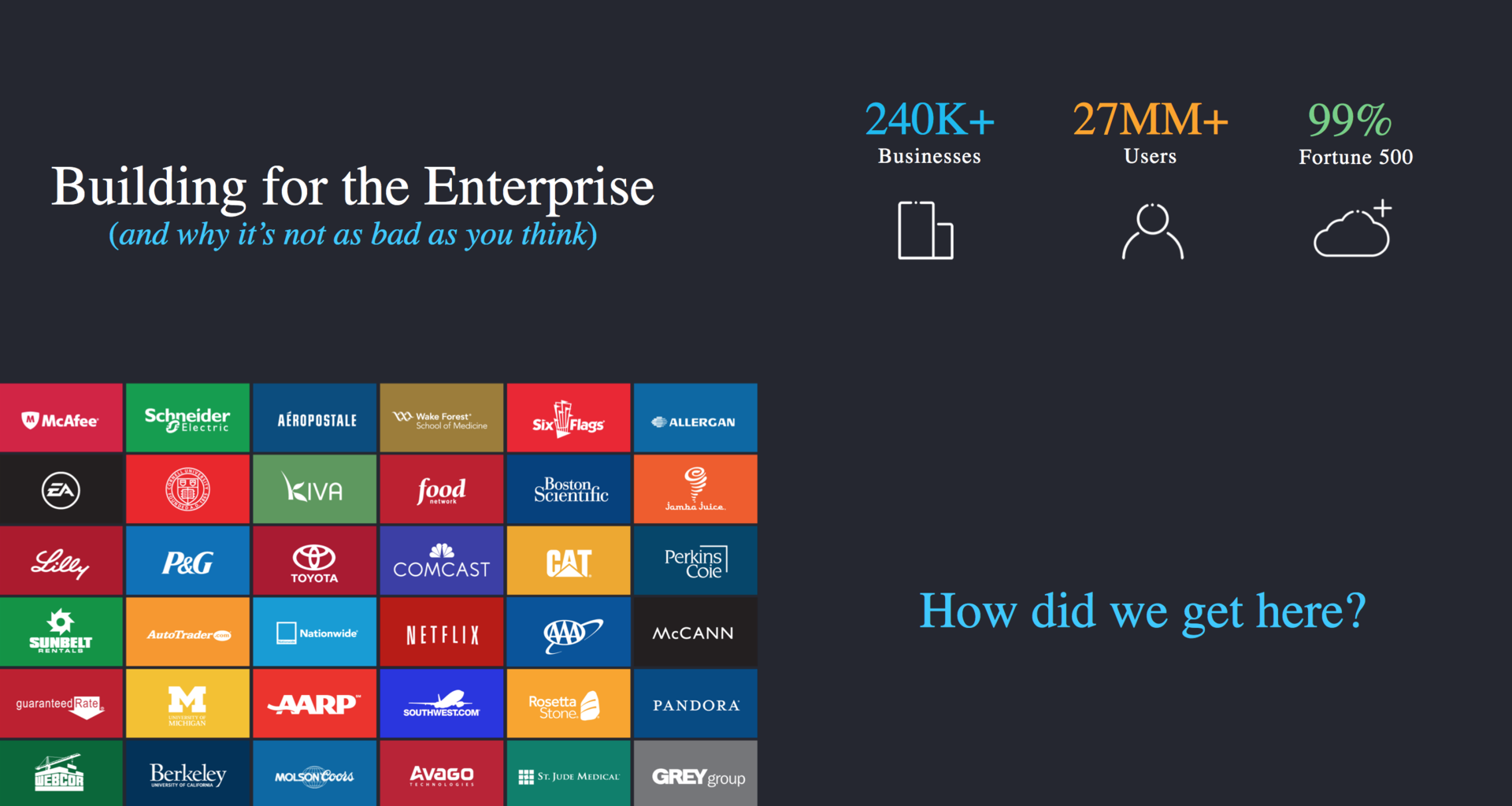
So, here are the general statistics on creating corporate software in Box. Box is used by approximately 240 thousand companies, more than 27 million users contributed to the spread of Box in their organizations, and this, in turn, accounts for 99% of the companies belonging to the Fortune 500. The remaining 1% is Microsoft, and it seems to me that they are not eager to buy our product. We need to work on this a bit.
Many people use Box in their workplaces, and here are a few examples of such organizations [slide with your tiles]. Our product is used in a very wide range of industries: from the production of consumer goods to companies like General Electric. Stanford Health Care also uses Box to coordinate workflow in medical departments. Health care, the media, production - this is only a small part of the industries with which we work.
The question is, how did we come to this?
We did not conceive of the company as a manufacturer of corporate software, it happened. We started the business in 2005, and the idea came to our mind in 2004, in college. Has anyone used the internet in 2004? Fine. I did not know that the generation of "zero" used the Internet, so great. Sorry, I will not joke about age anymore.
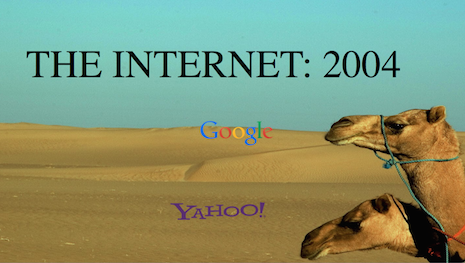
So, back to the case. You may remember that at that time [on the Internet] there was nothing to do especially. Boring time, isn't it? This is the time when there was no Facebook, Snapchat, and many other services, for example, you couldn’t share fifteen-second messages or photos with people, because you didn’t even have smartphones. Therefore, on the Internet in 2004, not a lot of things happened.
This is how the Internet looked like at that time: a deserted and abandoned landscape [slide with camels]. To clarify: the happy camel is Google, the sad one is Yahoo! .. This is how the Internet looked in 2004. Yahoo! have done a lot of work since then, but then, in mid-2004, they only tried to find their way. And Google has already captured markets on a global scale.
And so, in 2004, in college, we noticed that for some reason it is very difficult to exchange files. Today it looks like the simplest task, and you go back 10 years, at that time it was either very expensive or very difficult to transfer data within the company. Then I was an intern at one of these companies, and most of my work was that I printed the data on paper and carried it to the offices. You did this as an intern if you were not from the Faculty of Informatics. I was a pro in copying paper, unfortunately, this skill is not very useful today.
So, file sharing was problematic. In the classrooms, students worked in large groups, and it was also difficult for them to share files. When I studied at the University of Southern California, we were given 50 MB of disk space. At 50 MB, you can save one file, but they were deleted every 6 months. Whoever used IT at the time, he definitely didn’t use hard drives. That was the reality. And we thought: why don’t we simplify the file sharing and storage, allowing us to do this from anywhere on the planet?
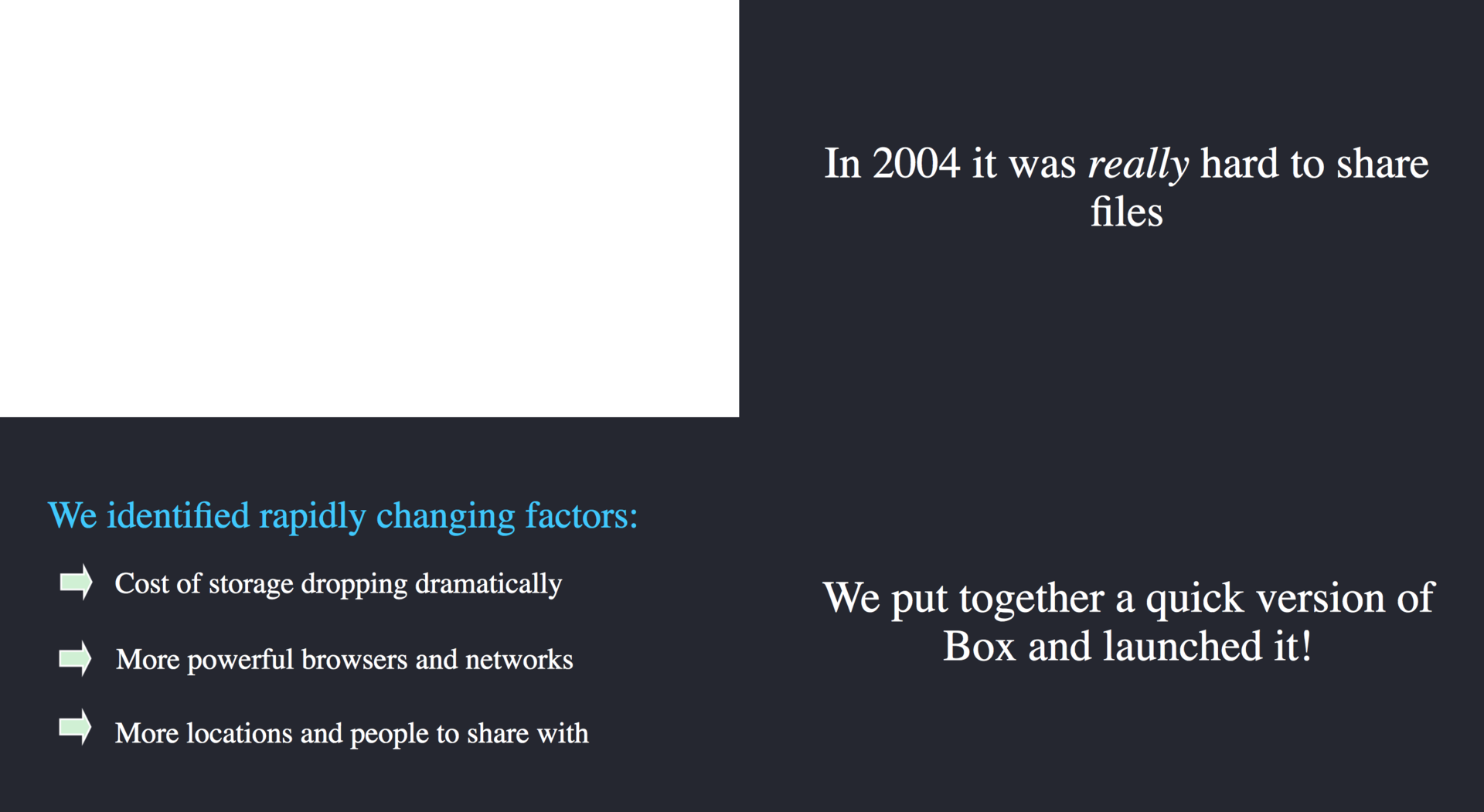
So we got the idea, then Box.net. We were struck by the many changes taking place in the software world. First, the cost of storing information has decreased significantly. In our business every two years can double the size of the storage of information on the hard disk. What was previously unprofitable, has become quite acceptable.
The cost of computing and the cost of storing information has decreased, we have more powerful browsers and networks. At that time, FireFox was just beginning to emerge. Faster internet appeared in people's homes and schools, and, as a result, more use-cases appeared when people wanted to store and share information.
These three factors served as the starting point. Remember them, and I will give you some tactical advice .
First - always watch for changes in technological factors. Any market based on major changes has always exposed these factors, which greatly influenced the state of affairs. We were very lucky with the growing need for data storage in the "cloud", and the cost of creating such a service, on the contrary, decreased. We decided to quickly assemble the first version of Box and launch it on Box.net. The idea was to simplify file sharing. And the idea “burned out”, we got an angel investment from a guy named Marc Cuban. That was before Shark Tank, but very much like him. We took the money and thought that everything would be very cool.

We were going to quit college and move to the San Francisco Bay Area, we thought everything would be just fine. When you quit college ... has anyone already quit college? OK I understood. Keep learning!
When someone leaves college, he always draws himself an amazing future. Bill Gates dropped out of college, so I will have everything like Bill Gates. Michael Dell also dropped out of college, so everything will be fine, just like Michael Dell. Steve Jobs dropped out of college ... these are pictures that people have in mind, but no one remembers this guy [photo on the slide in the lower right corner], and he also dropped out of college.
In fact, there is no guarantee that you will be successful if you drop out of college. It's funny, I'm not even sure that this guy really dropped out of college. He just looks like he had to. I apologize if anyone knows, this is just a funny picture from the Internet. So we decided to leave college and moved first to Berkeley and then to Palo Alto. We decided to make the product free; as a result, the increase in users amounted to a thousand people per month. Starting to use Box.net, you get one gigabyte of disk space for free, which was quite a lot by the standards of 2006. But the influx of users was so great that I had to find a way out of this situation.
What we have encountered is a frequent problem, any startup has to deal with it. In our business model it was fixed that we are building a very reliable and strong company for customers. But in fact, we created a trivial product. People who started working with our service had the opportunity to connect paid functions, but most users did not need them.
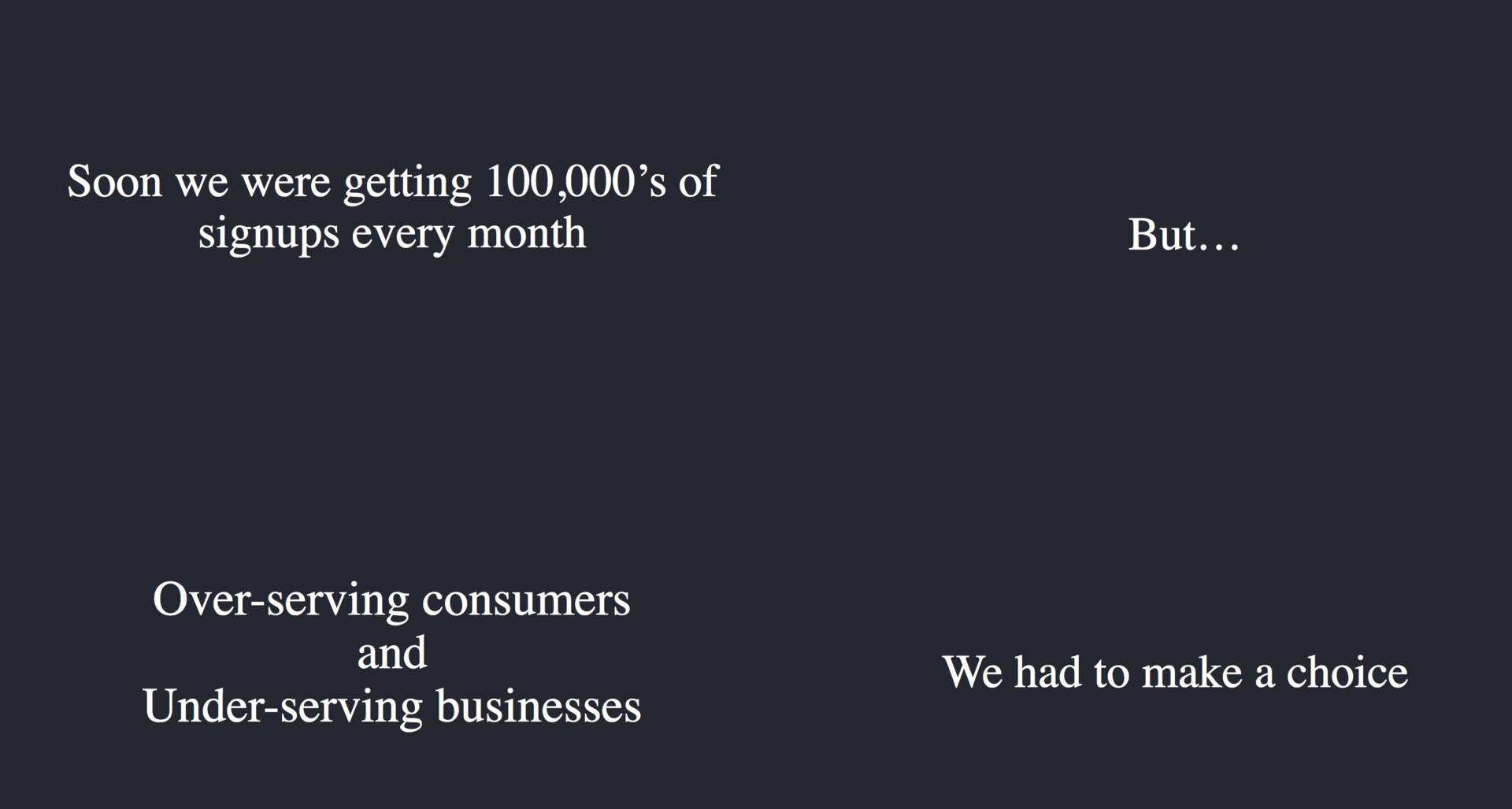
As for organizations, the protection of information was insufficient, and we did not have the opportunity to allow them to store our data with us. Therefore, it turned out that our service provided unnecessary features to a regular user, and did not have the necessary functions for organizations. We are in a difficult position. We were in a period when it is very difficult to determine what we want from our business. We had to make a choice. We were at a fork, and we had to decide which way to go.
All this happened around the second half of 2006. When we dropped out of college, I was 23 and my co-founder was 22, and our team was even younger. In 2006-2007, we saw two paths, and the worlds to which these paths led were very, very different. When you create a startup to work with consumers, it's mostly fun and exciting: you often go to parties.
While working with organizations you constantly struggle, because this business model is rather ungrateful: most often people hate corporate software. Somehow we imagined these two ways, and we had to choose from these two worlds. We looked at them and weighed. Well, working with consumers looks quite fun, and working with organizations looks very difficult and full of trials, but at the same time in the consumer sector you are always fighting for money. You are trying to get people to pay for the product. Only two business models are used in this area.
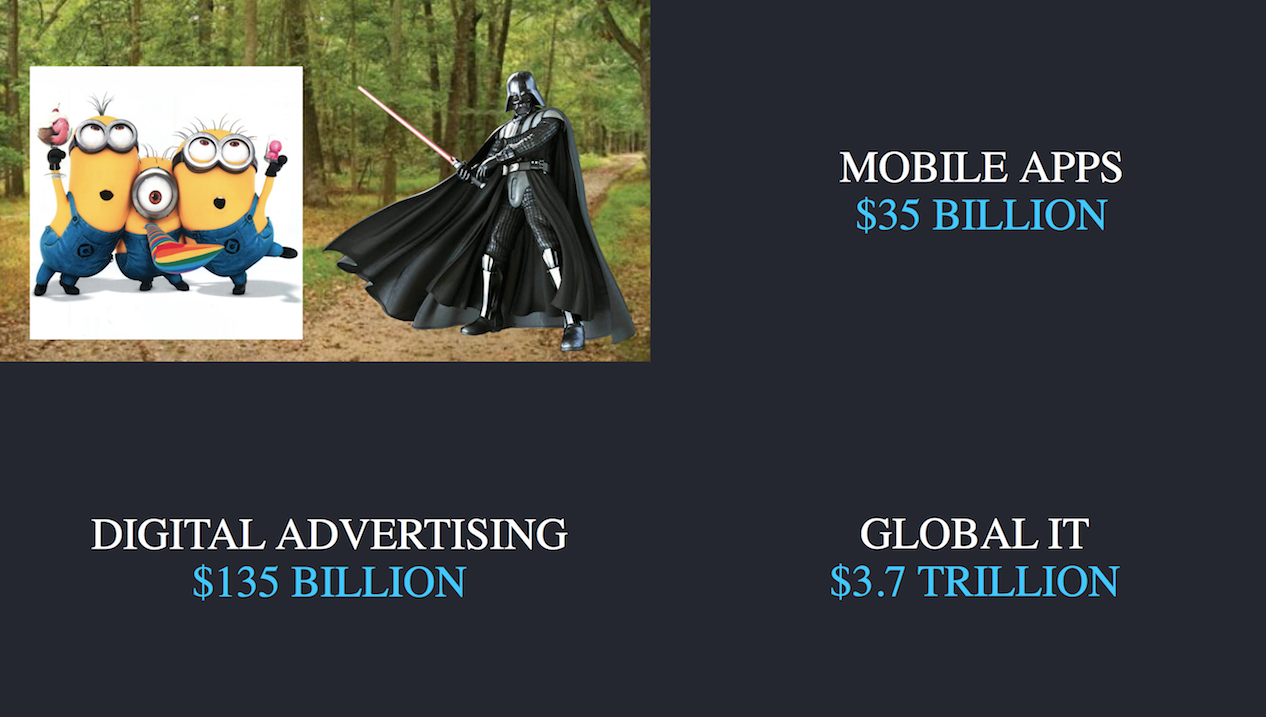
You can offer people to buy the app or you can earn on advertising. To give you an idea about this, here are some relevant numbers. In the b2c segment, about $ 35 billion is spent on mobile applications worldwide per year. Pretty big number, right? 35 billion dollars!
And the global digital advertising market is estimated at $ 135 billion. So if you don’t do e-commerce, then within the b2c model, aim for those 170 billion dollars coming from the sale of apps and ads. Such a large number opens up many possibilities.
However, in the b2b segment, technology spends $ 3.7 trillion each year. This amount includes the costs of servers, infrastructure, software, networks and services. All this mass of technology equals several trillions of dollars a year. We realized that there was quite a big difference between the two markets.
[If we chose the first option, we would have to] fight to make people pay a few dollars a month for the service, which, after some time, they will try to make free Google, Microsoft and Apple. At that time, it was already rumored that Google Drive was being prepared to come out, followed by other products. But in the corporate segment, they do not save money on information technology, everyone is trying to increase productivity and are trying to expand their business, and therefore the relationship to the value of [IT] is very different here.
In the consumer sector, we have a limited amount of money that we want to save, and therefore our task is to purchase as few things as possible. In a corporate environment, the question is posed differently: “What will this technology bring me? How profitable is it for me? ” This important point must be considered when making a decision.
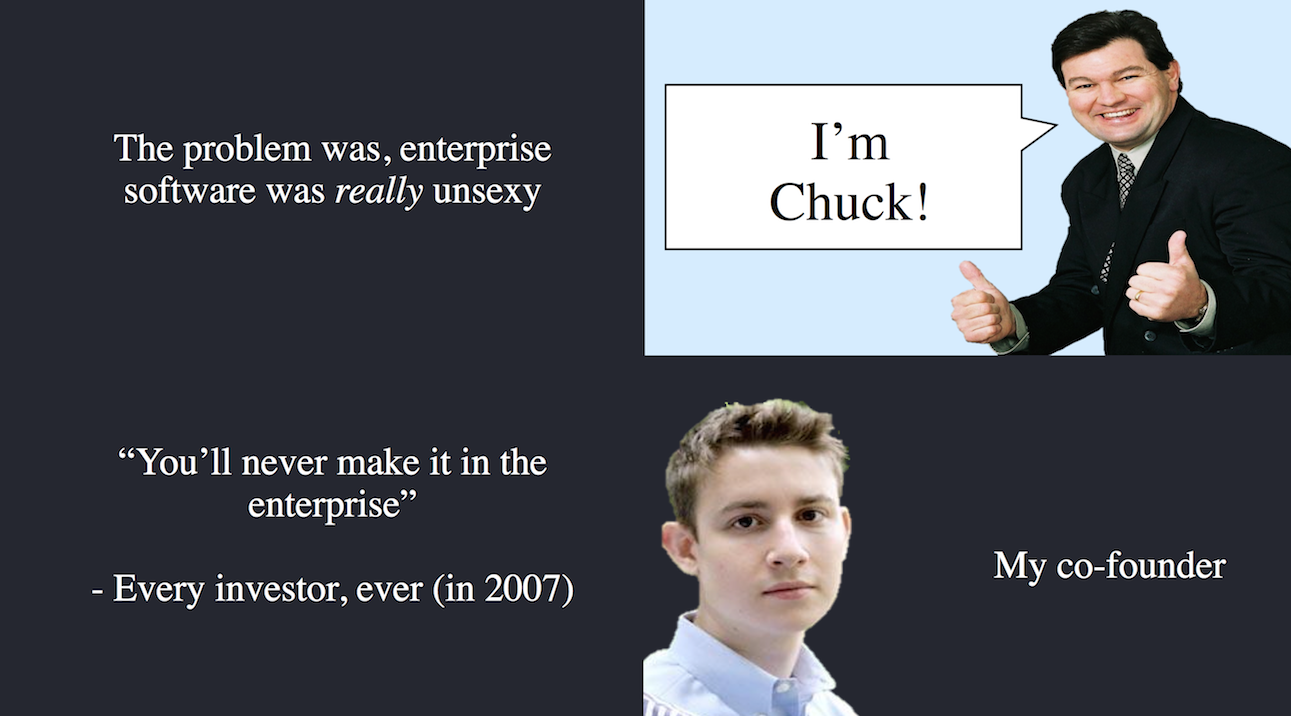
However, the problem was that the prospect of creating corporate software was very unattractive. This is a field of activity with very high competition, in conditions where it is difficult to build a business.
Nobody jumps out of bed with the thought: “I want so much to build a company to develop corporate software!”
And the reason for this is incredibly simple, which has always been: this software is created for an incredibly long time. This is a slow process, because in this environment you cannot make money from advertising, and sales take a long time, because customers are reluctant to acquire technology. I think we all know the common belief that when you try to sell corporate software, you have to spend several years convincing a company to buy it from you. Then it will take several more years to implement the technology as a priority [in the company]. Many companies for many years create products that are not used anywhere as the main ones.
One feels that this is a huge problem, and we would not want to get involved in it. Technology itself is not an easy thing, I don’t know how many people had to use corporate software, but such software is really complicated. You are trying to understand why the designer has placed 47 buttons on one page, and you can’t even guess why this is done that way.
I will answer this question in just a second. Typically, creating such software, developers do not care about the design and customer convenience, do not relate to the project with love, and it turns out just a complex product. If it seems to you that everything is still not so bad, think: how are you going to sell the developed software?
Anyone who loves the Internet and its capabilities may find it unattractive to have an intermediary for sales. You have to hire a bunch of people in each country who will be the only link between you and the client.
You hire a guy named Chuck , Chuck takes his portfolio and leaves to try to sell a lot of corporate software to customers. To clarify, this is what Chuck [slide] looks like. This is how the sales process looks, at least as you (at least in the company) and we represent it. Chuck looks happy, but he is just an intermediary anyway. Why don't we take advantage of the Internet and spread our technology in this way?
Why do we have to put up with sales through intermediaries to expand the business? The next few minutes we will devote to why our ideas about the sales process were wrong. We were scared, and so there were investors who said in 2007 that we had no chance to work with organizations.
“You have recruited a team of 20 year old boys, and you do not have a single person who would work in a big business. Microsoft, Oracle, IBM - these companies will crush you. It will be very, very difficult for you to succeed, ”that’s what we were told.
In fairness, I will say that to a certain extent they were right. We were a very inexperienced team and were just starting our career. For example, my co-founder looked like he was 13 years old, like this [slide].
Does this seem to matter? This is he, our financial director, and here, I think, he is about 29. But we looked as if we were going to take all the money and go to Disneyland. I understand why everyone thought that we would not pull. I can not imagine myself in the place of a man who will give him money.
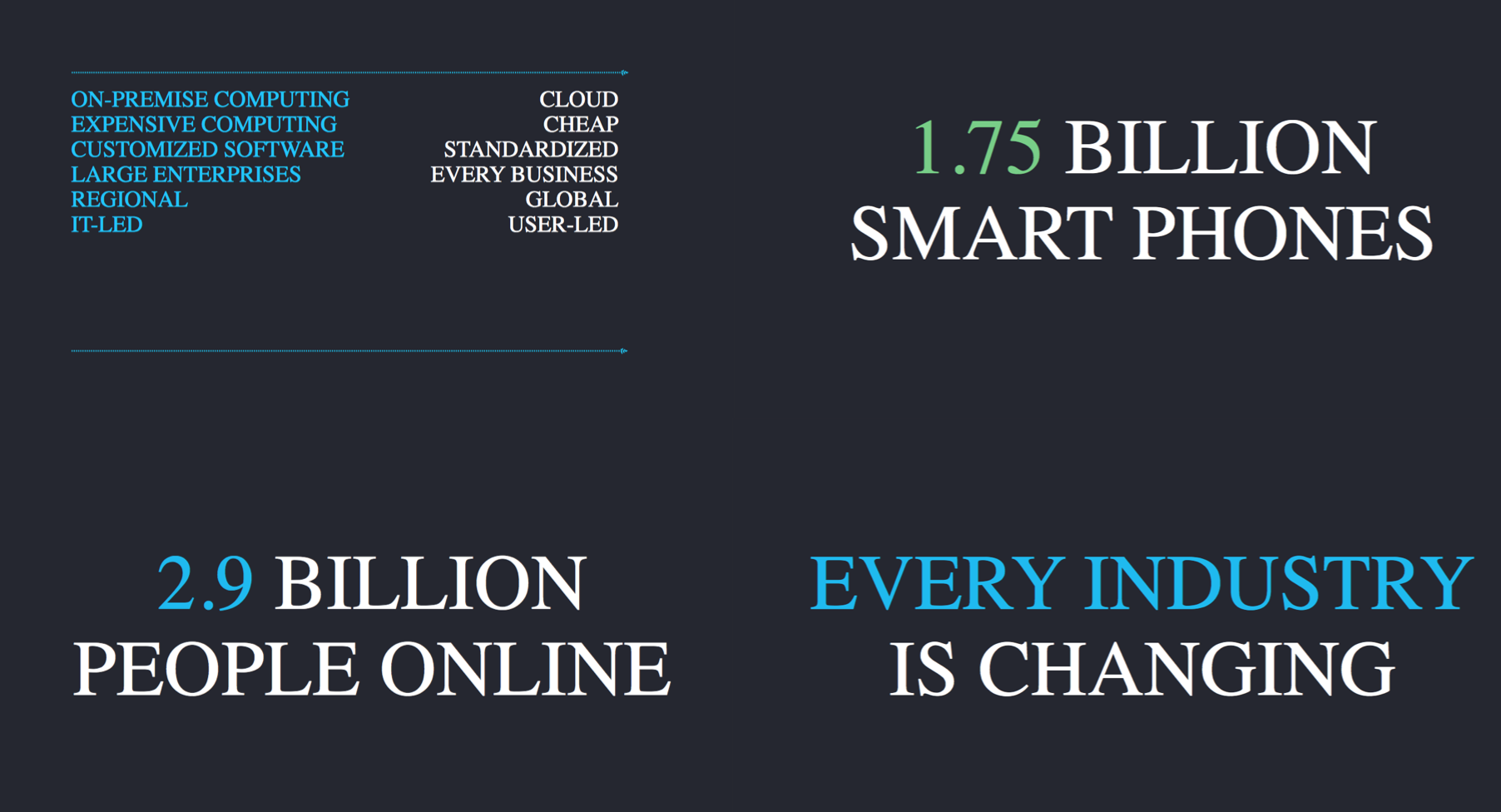
We still decided that we should do it. We decided that we should do our best and were going to use our scaling opportunities, the client experience we created, the very essence of our company and see if we can apply all this in a corporate environment.
We are very lucky. An investor appeared, just starting his career, who believed in us because there were some changes in corporations that could give us an advantage. We decided that if we are going to make a large company, if we are going to work with a large business, we must learn to play by the new rules.
It was decided to make big companies their clients and create software for them, and it was clear that we would have to play by completely different rules. Is it possible to make software easier? Is it possible to change the long sale process? How do we learn to sell our product directly instead of using a chain of intermediaries? How to create a design for the end user, and not just follow the requirements of the client?
Regarding most of these issues, we decided to act in the opposite way to what other players in the corporate software market did. We were going to understand what has changed in the technology world in order to build a new and better software development company. This is the decision we made, and this is why we set our sights on corporations - this is the way we embarked on 8 years ago.
I repeat, about 240,000 enterprises are working and using our product with us today. This is because we developed a business model, developed software and developed a solution for working exclusively with enterprises, and it turned out what we had in mind. I will delve a little into the story of what has changed in the world, and on the basis of what we have created a company.
And here is what I highly recommend to you: if you create a company for developing corporate software, then focus on your own technologies. In part, this played a role in the decision making, helped us to defy problems.
Over the past five years, many things have changed in enterprises, like the software itself. If there is a favorable time for the creation of a company to develop corporate software, this time has come, considering how many changes occur in organizations.
Let's go through a couple of them.
First, most application development companies are switching to cloud services. If you were going to create an enterprise management company, a company that manages the intellectual resources of an enterprise, or even a communications management company a few years ago, then you would have to ensure that the service is available in each country and city where there are customers. And no matter how large your client base is, no matter in which region, a separate data center should be created for each client.
This is a lack of separate processing - you would have to do extra work, hire extra labor, which slowed down the whole process of software development and its launch in the enterprise. Suddenly, a “cloud” appeared, and services like SalesSource.com and Amazon Web Services had their say.
They wondered why every customer who wants to install a couple of servers should connect them themselves, connect them to the data server with the network and ensure security so that they could “come to life” in 6 months and the developer could use them in the organization? Why is the same thing happening with apps? Why today it is the place to be? We can simply combine tens of thousands of servers and give them to work on demand, so that you can use them for anything you want and when you want. We can do this. Obviously, this was the definition of cloud computing.
As a result, IT directors and large companies benefited from this. For everyone who sits in this class, it is clear that creating your company, you do not buy your own servers, instead you use Google, Yahoo! or ashore. But corporations with years of infrastructure are forced to move to the "cloud" just now. That such a massive transition is happening now.
We are moving to the world of cheap computing on demand, from the world of expensive computing. The advantage of creating a startup is that the consumer market is not inertial, buyers are always ready to adopt a new technology. As soon as the cost of computing falls, it becomes easier to make and use new solutions. This means that the barrier to reviewing and presenting technology at the corporate level is reduced, which is great for startups.
We are moving from the world of specialized platforms to the world of software standardization. Once you had to customize the software yourself so that the client was satisfied, and now the clients understand that they can customize the interface without looking inside the tool complex.
It was like, having created corporate software, you could only sell it to 5-10 thousand of the best companies in the world, because only these companies have the means and infrastructure to cover the costs of technology and implement them in the enterprise. Today, companies consisting of two people (literally) can use Box, and we also work with General Electric, which employs more than 300 people.
The fact that you can serve small companies around the world on a par with the largest on the planet means that you can go to much larger markets.
And getting to the level above enterprises is a very profitable economic project. The platforms themselves are becoming more global - our customer community has become international a couple of weeks after the start of the company. If you create corporate software according to familiar canons, then it will take several years.
Finally, the most powerful change is related to mobile devices. iPhones and smartphones running Android, iPad tablet computers and other information technologies have become much more accessible to users. This is fundamentally important.
In the world of information technology, large companies usually win because they already have connections with organizations and their information technology directors, they are familiar with the demand and know what product is in demand. Today, users themselves are introducing technology. They start using them themselves in the sales department, in the marketing department, in financial areas, and you can already create software based on that. This means that company employees can start using corporate software, and later, you can sell it to an enterprise when they need better control, better protection and scalability.
So, you still have the same business model for corporate software development, but today, the path to product implementation in the enterprise lies through the end user .
There are more than 2 billion smartphones on the planet . Just 10 years ago, if you managed the company's technical facilities, then you were dealing with a network of computers located inside the building. But now, with billions of smartphones, you have to cope with a huge amount of computing technology that works at any time and on any network. This is an important point for software development companies, because no large enterprise that has existed for a long time has technologies that can support such a line of work and this way of managing data. This opens up tremendous opportunities for startups.
Nearly 3 billion people work online . In this regard, changes are occurring in all industries, and each enterprise changes its views on the ways in which its products are sold to consumers. The technological revolution in an enterprise can happen in just two ways.
The first reason is the change in raw materials. The cost of computing falls, they are centralized, and people use them as needed. The second reason that entails a change: if people who buy products of the enterprise, will need a new experience of use, in addition to this product. Let me give you an example. If you are going to go anywhere from campus, then you will probably use something like Uber or Lift. If you are in the forwarding business, or in the transportation business, then Uber will lead to huge changes in your industry. You cannot allow Uber to exist without realizing what consequences it will lead to. What will be the effects of Instacart? What will the use of Lift in my business model lead to?
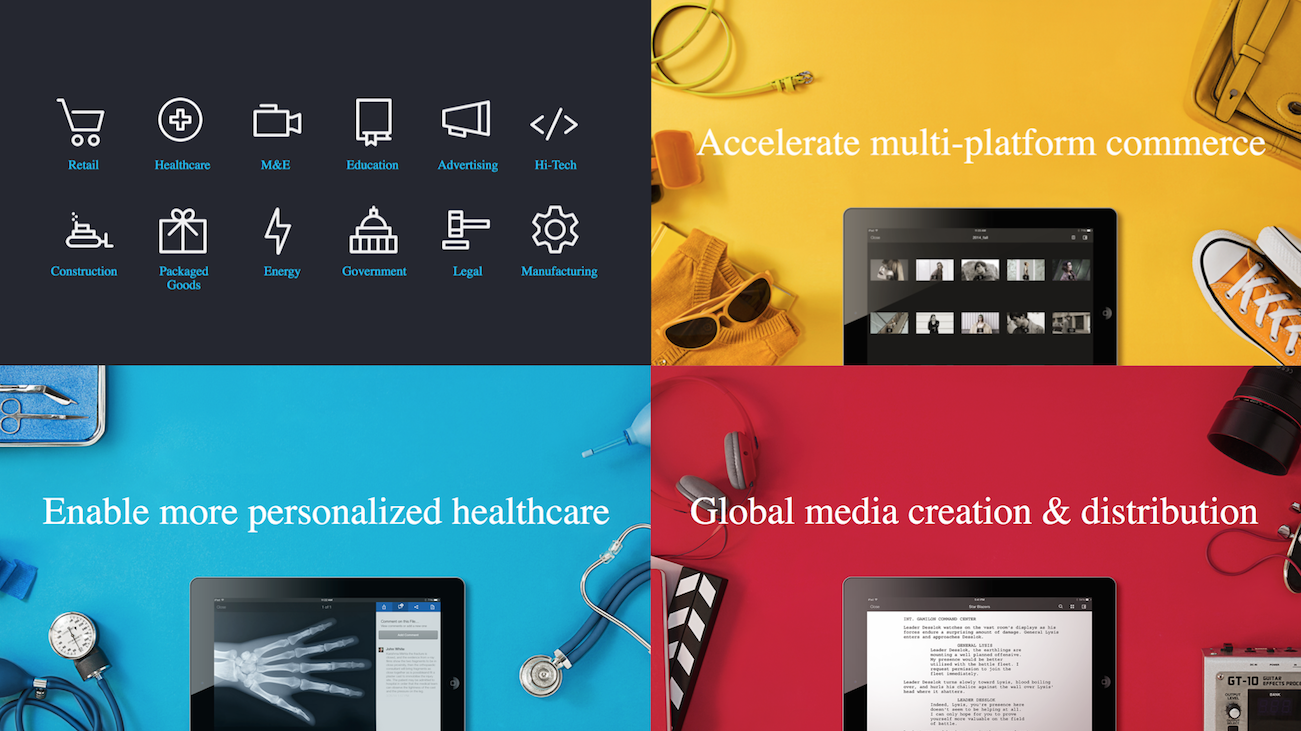
, , , , - . . -, , , .
: . , , , . . , , , , , .
. . - , , . , , .
, , . : , ? , .
– . , – - . , 3 , iTunes , . , , 3 . , , , .

-, , , . . , , .
, . . , , , - . . , ? , .
, . , . ? , , . , .
5-10 , , , . , , - . .
, . , , , , , , , , . , . , , .
– . , , .
, .
, – , , , . , , , , .
, . , ? ?
, 10-15 - , . , , 1990 1980 , – , – , 10, 20, 30 .
, , . , – , 5 10 , . . PlanGrid, - PlanGrid? , . ? ? , ! What would it mean?
. PlanGrid – , , , , . , , 4 . , , .
, iPad – , , . , , .
, ? , , ? PlanGrid . , , .

, . , , , « » .
( ). , , . , : « , . -, , ».
, , , , . , , . , . , .
ZenPayroll , . , – .
e-mail, .. . ZenPayroll :
« , : . , ».
- , . ZenPayroll , , , ? , , - , , , .
.
, , - - . .
, , . , - . , , , . , , .
, – - -, .
– . - – , , . – . [], , - .
Zenefits , , , , , . , - , , . Zenefits – . -, . , . - .
, . , , -, , . . . , , , .
, Skycatch , . , . Skycatch , . Skycatch , b2b-.
– . , , , , . , .
, , .
, . , – , , , . , , , . Palantir – , , .
, , – , .
, , . , – . , .
, – . , . .
, , , . , , . , . , .
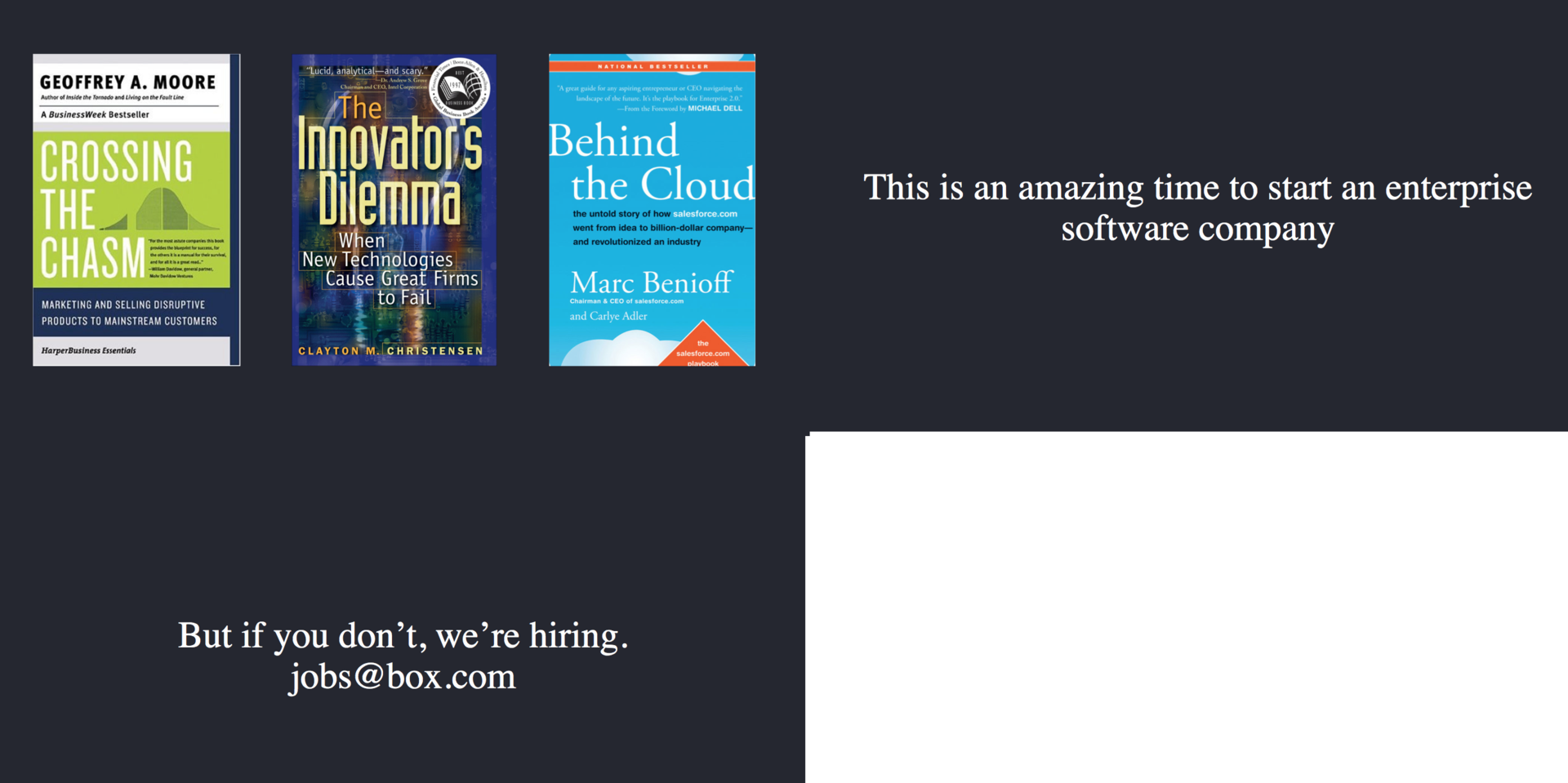
Thus, in conclusion of today's lecture, I would like to recommend these books and say that now is a great time to create a company to develop corporate software. I wish you good luck. If something does not work for you, then pay attention to our vacancies. The only thing, please, do not compete with me, I already have enough competitors. Ideally, either work with us, or build your own company.
Thank you very much for your attention!
Source: https://habr.com/ru/post/253093/
All Articles